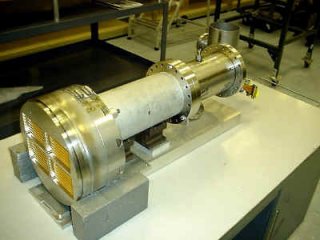

 The Atlas liquid argon calorimetry is composed of a barrel section and of two
endcap sections. Each endcap cryostat contains an electromagnetic
calorimeter, two wheels of a hadronic calorimeter, and a forward calorimeter.
The liquid argon calorimeters have approximately 200, 000 signal and
calibration lines that are routed to the outside of each endcap cryostat via
25 feedthrough assemblies arranged approximately equally spaced in azimuth.
The low voltage needed to operate the endcap hadronic calorimeter
preamplifiers, which are located in the cold are also supplied via the signal
feedthroughs, as well as various monitoring lines.In addition to the
electrical constraints of total resistance, impedance, and limited crosstalk,
these feedthroughs must be robust because any leak of the liquid or vacuum
could jeopardize the entire experiment.
The Atlas liquid argon calorimetry is composed of a barrel section and of two
endcap sections. Each endcap cryostat contains an electromagnetic
calorimeter, two wheels of a hadronic calorimeter, and a forward calorimeter.
The liquid argon calorimeters have approximately 200, 000 signal and
calibration lines that are routed to the outside of each endcap cryostat via
25 feedthrough assemblies arranged approximately equally spaced in azimuth.
The low voltage needed to operate the endcap hadronic calorimeter
preamplifiers, which are located in the cold are also supplied via the signal
feedthroughs, as well as various monitoring lines.In addition to the
electrical constraints of total resistance, impedance, and limited crosstalk,
these feedthroughs must be robust because any leak of the liquid or vacuum
could jeopardize the entire experiment.
The specifications that drove the technical design of the feedthrough assembly are quite complex. They involve geometrical and space constraints in the cryostat design, physical limitations on the space which is allocated to the feedthroughs, signal transmission quality, vacuum integrity, heat loss considerations, access possibilities, and installation, reliability and cost issues.
The design is based on gold plated conductive pins insulated and sealed by ceramic or glass inserts in a stainless steel carrier. The carriers are then welded into the cold and ambient (temperature) flanges. A total of 1920 signal and calibration lines per feedthrough assembly is required in the chosen design. The ambient and cold flanges are connected by a bellows to isolate the feedthrough vacuum from the main vacuum. The cold flange is attached to a transition piece, known as a funnel, which is welded to the cryostat via a bi-metallic joint. The electrical signals are brought from the calorimeter to the cold flange by coaxial kapton cables; these are called Pigtails. Cables located in the vacuum between the cold and the ambient flange, i.e. inside the bellows, carry the signals through the cryostat wall.